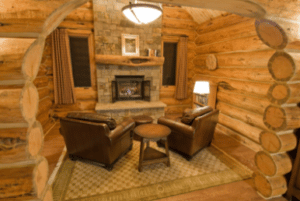
The exterior of a log cabin is created out of two central visible components: the logs and the chinking. The chinking is the flexible insulating sealant you see between each log. The main purpose of log chinking is to keep air and water from infiltrating your home through the spaces between the logs.
Log chinking is made out of fine sand granules and latex polymers that adhere to the logs. The chinking is flexible so as logs move and settle the chinking moves with it. There is no annual maintenance necessary.
How Does it Work?
When correctly installed, chinking is the insulating barrier preventing penetration into your home by water, air and insects.
Correctly installed chinking involves almost zero maintenance. It’s weathertight, sealed, and permanent so you don’t have to worry about redoing the chinking on a regular basis.
What is Daubing?
Historically, chinking was instead known as daubing. This process was similar to chinking, but previous log cabin builders would use other substances to fill the space between their homes’ logs. It was made out of anything the builder could find that would provide insulation and protection from the elements. This included mixtures of mud, sand, grass, twigs, and even hair.
Preventing Air and Water Infiltration
The main reason we use chinking is is prevent water and air from entering your home through cracks or poorly sealed sections on your log home’s exterior. Warm or cool air leaking from your home or entering your home in the wrong season can end in discomfort for you and your family as well as a skyrocketing energy bill.
In addition to chinking, you can use varying caulks and sealants to further keep unwanted air and water from entering your home.
Common Air and Water Leak Locations
Unwanted air and water can enter your home through:
- Poor attic sealing
- Improperly sealed shafts and ducts
- Ineffectively sealed windows and doors
- Living space to garage walls
- Stair framing when located at an exterior wall
- Chimney Shafts
- The floor and foundation
Air Leaks
Once a log home is built, we can use many different devices and techniques to find where air is leaking in.
- Infrared imaging creates a visual on where heat is leaking or on where cold air is entering.
- Checking ducts helps builders to be sure no heat is escaping through the duct system.
- Blower door testing involves a fan that fits inside a doorway in order to measure air leakage.
Whatever style of log home you are going for, log chinking is a necessary element for comfort and a lower power bill. Make sure you have the chinking right by calling our team of experts at Frontier Log Homes – 970-249-7130.

